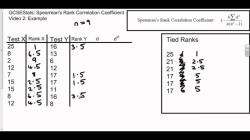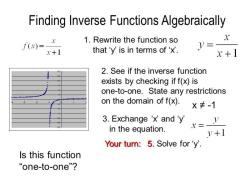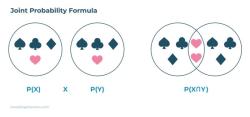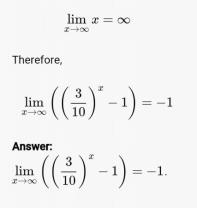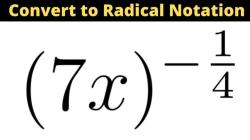How CNA you write the expression with a rationalized denominator?
To write an expression with a rationalized denominator, you need to eliminate radicals (square roots, cube roots, etc.) from the denominator. Rationalizing the denominator typically involves multiplying both the numerator and denominator of the fraction by an appropriate expression that will remove the radical. Here are the steps to do this:
Step 1: Identify the Radical in the Denominator:
- Identify the term or expression in the denominator that contains the radical. This might be a square root (√), cube root (∛), or other radicals.
Step 2: Determine the Rationalizing Factor:
- To rationalize the denominator, you'll need to multiply by a factor that eliminates the radical. The type of factor you use depends on the type of radical in the denominator.
- For a square root (√), multiply by the conjugate of the denominator, which is the same expression but with the opposite sign between the terms. For example, if the denominator is √a, multiply by √a in the numerator and denominator.
- For a cube root (∛), multiply by an appropriate expression that will result in a rational denominator.
Step 3: Multiply Numerator and Denominator:
- Multiply both the numerator and denominator by the rationalizing factor you determined in Step 2. This ensures that you're not changing the value of the original expression.
Step 4: Simplify If Necessary:
- After multiplying, simplify the resulting fraction if possible. Cancel out common factors, and ensure that the expression is in its simplest form.
Step 5: Express the Rationalized Denominator:
- Write down the expression with the rationalized denominator.
Here are a couple of examples to illustrate these steps:
Example 1 - Rationalizing a Square Root Denominator:
Original Expression: 2 / √3
Step 1: Identify the Radical - The radical is √3.
Step 2: Determine the Rationalizing Factor - Multiply by the conjugate of the denominator, which is √3.
Step 3: Multiply Numerator and Denominator:
- (2 / √3) * (√3 / √3) = (2√3) / 3
Step 4: Simplify:
- The expression is already simplified.
Step 5: Express the Rationalized Denominator:
- The expression with a rationalized denominator is (2√3) / 3.
Example 2 - Rationalizing a Cube Root Denominator:
Original Expression: 4 / ∛2
Step 1: Identify the Radical - The radical is ∛2.
Step 2: Determine the Rationalizing Factor - Multiply by (∛4 / 2).
Step 3: Multiply Numerator and Denominator:
- (4 / ∛2) * (∛4 / 2) = (4∛4) / 2
Step 4: Simplify:
- (4∛4) / 2 = 2∛4
Step 5: Express the Rationalized Denominator:
- The expression with a rationalized denominator is 2∛4.
In both examples, the original expressions had radicals in the denominator, and by following the steps to rationalize the denominator, we obtained expressions with rationalized denominators.
Rationalizing Denominators: Expressions and Techniques
Rationalizing a denominator means to rewrite a fraction so that the denominator is rational, meaning it does not contain any radicals. This can be done by multiplying the numerator and denominator by a suitable expression.
There are two main techniques for rationalizing denominators:
- Factoring: If the denominator contains a radical, you can try to factor it into simpler terms. If you can factor out a perfect square, you can then multiply the numerator and denominator by the square root of the perfect square to rationalize the denominator.
- Conjugates: If the denominator contains a binomial radical of the form , you can multiply the numerator and denominator by the conjugate of the denominator, which is . This will rationalize the denominator and simplify the fraction.
Simplifying with Rationalized Denominators: Mathematical Methods
Once you have rationalized the denominator of a fraction, you can simplify the fraction by dividing the numerator and denominator by any common factors. You can also use other mathematical methods to simplify the fraction, such as factoring and combining like terms.
Mathematical Expression Transformation: Rationalizing Denominators
Rationalizing denominators is a mathematical expression transformation that can be used to simplify and manipulate fractions. It is a useful technique to know for solving a variety of mathematical problems, including algebra, calculus, and physics problems.
Here are some examples of how to rationalize denominators:
Example 1:
Rationalize the denominator of the following fraction:
\frac{1}{\sqrt{2}}
To do this, we multiply the numerator and denominator by the conjugate of the denominator, which is .
\frac{1}{\sqrt{2}} \times \frac{\sqrt{2}}{\sqrt{2}} = \frac{\sqrt{2}}{2}
The denominator of the fraction is now rational, so the fraction is simplified.
Example 2:
Rationalize the denominator of the following fraction:
\frac{3}{\sqrt{5}}
To do this, we multiply the numerator and denominator by the conjugate of the denominator, which is .
\frac{3}{\sqrt{5}} \times \frac{\sqrt{5}}{\sqrt{5}} = \frac{3\sqrt{5}}{5}
The denominator of the fraction is now rational, so the fraction is simplified.
Example 3:
Rationalize the denominator of the following fraction:
\frac{2}{2 + \sqrt{3}}
To do this, we multiply the numerator and denominator by the conjugate of the denominator, which is .
\frac{2}{2 + \sqrt{3}} \times \frac{2 - \sqrt{3}}{2 - \sqrt{3}} = \frac{4 - 2\sqrt{3}}{1}
The denominator of the fraction is now rational, so the fraction is simplified.
Rationalizing denominators is a powerful technique that can be used to simplify and manipulate fractions. By understanding how to rationalize denominators, you can make solving a variety of mathematical problems easier.








